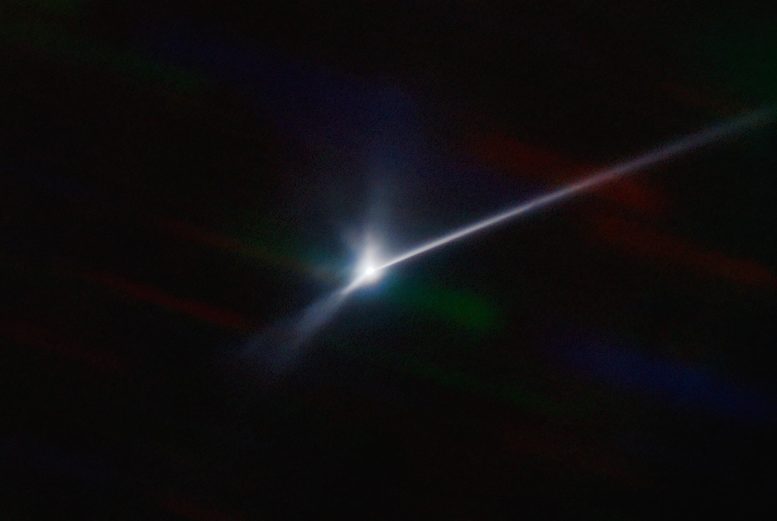
Astronomers using the SOAR telescope in Chile captured the vast plume of dust and debris blasted from the surface of the asteroid Dimorphos by NASA’s DART spacecraft when it collided on September 26, 2022. In this image, the more than 10,000-kilometer-long dust trail — the ejecta that has been pushed away by the Sun’s radiation pressure, not unlike the tail of a comet — can be seen stretching from the center to the right-hand edge of the field of view. Credit: CTIO/NOIRLab/SOAR/NSF/AURA/T. Kareta (Lowell Observatory), M. Knight (US Naval Academy), Image processing: T.A. Rector (University of Alaska Anchorage/NSF’s NOIRLab), M. Zamani & D. de Martin (NSF’s NOIRLab)
SOAR Telescope Catches Dimorphos’s Expanding Comet-like Tail After DART Impact
The SOAR Telescope in Chile imaged the more than 10,000 kilometers long trail of debris blasted from the surface of Dimorphos two days after the asteroid was impacted by NASA’s DART spacecraft.
NASA’s Double Asteroid Redirection Test (DART) spacecraft deliberately slammed into Dimorphos, the asteroid moonlet in the double-asteroid system of Didymos, on Monday, September 26, 2022. This was the first planetary defense test in which a spacecraft attempted to modify the orbit of an asteroid through kinetic impact.
“It is amazing how clearly we were able to capture the structure and extent of the aftermath in the days following the impact.” — Teddy Kareta
Two days after DART’s collision, astronomers Teddy Kareta (Lowell Observatory) and Matthew Knight (US Naval Academy) captured the vast plume of dust and debris blasted from the asteroid’s surface with the 4.1-meter Southern Astrophysical Research (SOAR) Telescope,[1] at NSF’s NOIRLab’s Cerro Tololo Inter-American Observatory in Chile. In this new image, the dust trail — the ejecta that has been pushed away by the Sun’s radiation pressure, similar to the tail of a comet — can be seen stretching from the center to the right-hand edge of the field of view, which is about 3.1 arcminutes at SOAR using the Goodman High Throughput Spectrograph. At Didymos’s distance from Earth at the time of the observation, that would translate to at least 6,000 miles (10,000 kilometers) from the point of impact.
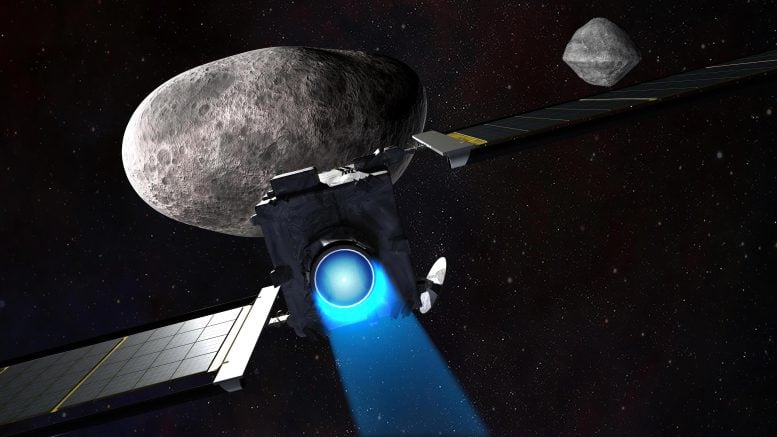
An artist’s representation of NASA’s DART spacecraft flying toward the twin asteroids, Didymos and Dimorphos. The larger asteroid, Didymos, was discovered by the University of Arizona’s Spacewatch in 1996. Credit: NASA/Johns Hopkins University Applied Physics Laboratory
“It is amazing how clearly we were able to capture the structure and extent of the aftermath in the days following the impact,” said Kareta.
“Now begins the next phase of work for the DART team as they analyze their data and observations by our team and other observers around the world who shared in studying this exciting event,” said Knight. We plan to use SOAR to monitor the ejecta in the coming weeks and months. The combination of SOAR and AEON[2] is just what we need for efficient follow-up of evolving events like this one.”
These observations will allow researchers to gain knowledge about the nature of the surface of Dimorphos. They will be able to gauge how much material was ejected by the collision, how fast it was ejected, and the distribution of particle sizes in the expanding dust cloud. For example, the observations will reveal whether the impact caused the moonlet to throw off big chunks of material or mostly fine dust. Analyzing this data will help astronomers protect Earth and its inhabitants by better understanding the amount and nature of the ejecta resulting from an impact, and how that might alter an asteroid’s orbit.
SOAR’s observations demonstrate the capabilities of NSF-funded AURA facilities in planetary-defense planning and initiatives. In the future, Vera C. Rubin Observatory, funded by NSF and the US Department of Energy and currently under construction in Chile, will conduct a census of the Solar System to search for potentially hazardous objects.
Didymos was discovered in 1996 with the University of Arizona 0.9-meter Spacewatch Telescope located at Kitt Peak National Observatory, a Program of NSF’s NOIRLab.
Notes
- SOAR is designed to produce the best quality images of any observatory in its class. Located on Cerro Pachón, SOAR is a joint project of the Ministério da Ciência, Tecnologia e Inovações do Brasil (MCTI/LNA), NSF’s NOIRLab, the University of North Carolina at Chapel Hill (UNC), and Michigan State University (MSU).
- The Astronomical Event Observatory Network (AEON) is a facility ecosystem for accessible and efficient follow-up of astronomical transients and Time Domain science. At the heart of the network, NOIRLab, with its SOAR 4.1-meter and Gemini 8-meter telescopes (and soon the Víctor M. Blanco 4-meter Telescope at CTIO), has joined forces with Las Cumbres Observatory to build such a network for the era of Vera C. Rubin Observatory’s Legacy Survey of Space and Time (LSST). SOAR is the pathfinder facility for incorporating the 4-meter-class and 8-meter-class telescopes into AEON.
More information
NSF’s NOIRLab, the US center for ground-based optical-infrared astronomy, operates the international Gemini Observatory (a facility of NSF, NRC–Canada, ANID–Chile, MCTIC–Brazil, MINCyT–Argentina, and KASI–Republic of Korea), Kitt Peak National Observatory (KPNO), Cerro Tololo Inter-American Observatory (CTIO), the Community Science and Data Center (CSDC), and Vera C. Rubin Observatory (operated in cooperation with the Department of Energy’s SLAC National Accelerator Laboratory). It is managed by the Association of Universities for Research in Astronomy (AURA) under a cooperative agreement with NSF and is headquartered in Tucson, Arizona. The astronomical community is honored to have the opportunity to conduct astronomical research on Iolkam Du’ag (Kitt Peak) in Arizona, on Maunakea in Hawai‘i, and on Cerro Tololo and Cerro Pachón in Chile. We recognize and acknowledge the very significant cultural role and reverence that these sites have to the Tohono O’odham Nation, to the Native Hawaiian community, and to the local communities in Chile, respectively.

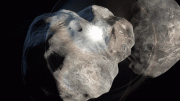
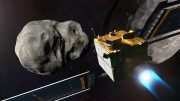
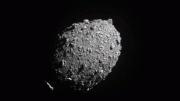
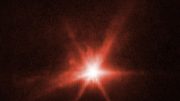
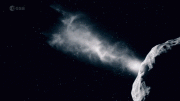
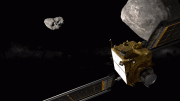
So, as the scifi movies predicted, instead of one giant blast to kill half of us, we blast it into a million lethal pieces to kill all of us on the same collision course.
No deflection! A total failure.waste of tax revenues. Why no news on extent of dimorphism orbital deflection ?
Would be nice to see the image of the debris trail. I would expect it would be altered by the gravity of its partner.
Agree with Fred Hafezi,
There NO deflection that’s why there is no mention of THAT specific and actual objective of the test. Waste of time of money that could have been used for more important, crucial and critical purposes and issues we are actually living today.
Now do those of you who posted a few days ago feel like a BOZO? You should.
Really @Fred and @Robert? Can’t wait the 5-minutes for SCIENCE to do it’s work – you had to declare it a waste of money that YOU didn’t have YOUR expected ROI immediately? I hope you can take this moment to do some introspection about how a scientific experiment is run – and that instant gratification should NEVER be the goal.
Huge win in terms of PLANETARY DEFENSE. You understand the risk is total annialition of the human species vs. a few dollars?